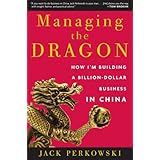
Average Reviews:

(More customer reviews)Are you looking to buy Managing the Dragon: How I'm Building a Billion-Dollar Business in China? Here is the right place to find the great deals. we can offer discounts of up to 90% on Managing the Dragon: How I'm Building a Billion-Dollar Business in China. Check out the link below:
>> Click Here to See Compare Prices and Get the Best Offers
Managing the Dragon: How I'm Building a Billion-Dollar Business in China ReviewThis is an admiring effort by an American entrepreneur, as fairly reviewed by Victor Mallet for the Financial Times:"Brash optimism of an American in China
You have to hand it to Jack Perkowski. The working-class Pittsburgh kid who won a football scholarship to Yale, spent 20 years on Wall Street and became head of investment banking at PaineWebber could have rested on his laurels and enjoyed his personal wealth.
Instead he chose in the 1990s to set up a new business in a difficult country and in a difficult industry he knew nothing about. This book is the story of how Perkowski went to China and established a Chinese motor components group called Asian Strategic Investments Corporation, now Asimco Technologies.
Managing the Dragon is not a great work of literature. The memoir Mr China by Tim Clissold, a Chinese-speaking accountant who helped Perkowski build Asimco, covered some of the same ground with more eloquence and wit four years ago. But Perkowski's book is worth reading, both for its insights into business in China and for its self-portrait of a relentlessly optimistic American entrepreneur who has persevered in spite of disasters and disappointments.
From a new vantage point - he spoke no Chinese but understood Wall Street and raised the money - Perkowski describes the horrors that also featured in Clissold's book: bureaucracy, fraud, corruption, competition from Asimco's Chinese joint venture partners, an inadequate legal system and invoices paid with trucks rather than cash.
As Perkowski admits, China is changing extraordinarily fast and most of these events happened a decade ago. But the book's central section - including a blow-by-blow account of how Asimco removed the awkward boss of a rubber products joint venture in Anhui province - make gripping reading for any industrial investor contemplating a move to China.
Clissold wrote that he was "confused" by the optimism of Perkowski - whom he described as "an enormous personality" and an "archetypal Wall Street adventurer" - and it is true that the American, even in his own writing, comes across as guileless and naive. Perkowski seems to crave recognition and at first appears surprised by how different Chinese habits are from American ones. Occasionally he draws lessons so obvious as to be useless, such as: "I have learnt that getting the strategy right is one of the most important things that a company can do."
Yet there is wisdom, too, on dealmaking and management in the world's most populous nation.
Perkowski chose the almost virgin business territory of China when he learnt that other Asian economies were in the grip of a few powerful business families (the subject of Joe Studwell's Asian Godfathers). He sensibly lays to rest the absurd myth that guanxi or connections are unique to Chinese dealmaking, pointing to his own use of guanxi as a graduate of Yale. And, half in jest, he recommends giving a new company eager for recognition a name beginning with A.
The core of Perkowski's argument is that investors in China face a "management gap" between bureaucratic managers reared in state-owned companies and managers so entrepreneurial that they "concocted deals with criminal elements or tried to set themselves up in competition with us".
Through painful years of trial and error, Perkowski and Asimco struggled to bridge this gap. They started with expatriate managers, but that did not work and Perkowski admits he made his biggest mistakes in the early days "when I discounted the views of my Chinese managers". Next, they tried converting the unsuitable "bureaucratic" and "entrepreneurial" Chinese managers they already had into the kind they wanted, but by and large that failed too.
Finally, they decided to find and empower Asimco's own "New China managers", open-minded mainlanders with some management experience, some exposure to modern management concepts and, typically, an engineering background. In retrospect this was as obvious as the need for a strategy, but it was evidently effective.
The question remains as to whether Perkowski needed to go through such agonies to build a company that now has 17 factories in eight provinces in China.
Clissold could not understand why Perkowski did not learn Chinese. This is a sore point for Perkowski. Although he writes that 90 per cent of the mistakes made in China are due to "misunderstanding and miscommunication", he spends nearly three pages justifying his reluctance to try to learn to speak Chinese.
Reading the two books together, one of the most valuable lessons to emerge is that if you want to build a billion-dollar business, it pays to learn the local language."
For more wisdom, I also recommend The Chine Executive by Wei Wang - a great thinker on this topic, in my view.
Managing the Dragon: How I'm Building a Billion-Dollar Business in China Overview
Want to learn more information about Managing the Dragon: How I'm Building a Billion-Dollar Business in China?
>> Click Here to See All Customer Reviews & Ratings Now
0 comments:
Post a Comment